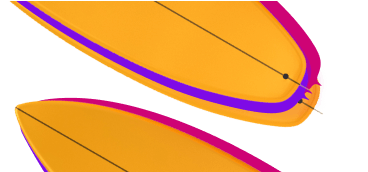How to choose a board?
January 8, 2025

How to choose a board ?
Choosing a surfboard involves considering several factors such as your skill level, surfing conditions, body type, and personal preferences. Here are some steps to help you choose the right surfboard:
- Determine your skill level: Are you a beginner, intermediate, or advanced surfer? This will influence the type of surfboard that suits your abilities. Beginners typically start with longer, wider, and more stable boards, while advanced surfers often prefer smaller, more maneuverable boards.
- Consider the type of waves you'll be riding: Different surfboard shapes are designed for specific wave conditions. If you surf in small, mushy waves, you may want a board with more volume and buoyancy. For larger, steeper waves, you might prefer a board that offers more maneuverability and control.
- Assess your body type: Your weight, height, and fitness level play a role in selecting the right surfboard. Generally, heavier individuals require more volume and buoyancy to support their weight, while lighter surfers can opt for smaller boards.
- Understand the different surfboard types: There are various types of surfboards, each with its own characteristics. Some common types include
• Longboards: These are long, stable boards that provide a smooth and forgiving ride, making them suitable for beginners or surfers looking for a relaxed style.
• Shortboards: Shorter and more maneuverable, shortboards are favored by intermediate to advanced surfers who seek high-performance surfing and tighter turns.

- Fish boards: Fish boards are wider, shorter, and have a swallowtail design. They excel in smaller, mushier waves, offering speed and maneuverability.
- Funboards: Funboards are a hybrid between longboards and shortboards, providing the stability of a longboard with the maneuverability of a shortboard. They suit a variety of skill levels and wave conditions.
- Performance shortboards: These boards are designed for advanced surfers who want maximum control, speed, and maneuverability. They are typically shorter and narrower, with less volume.
- Gun boards: Gun boards are longer and narrower boards designed for riding large, powerful waves. They are intended for experienced surfers only.
1 Seek advice from experienced surfers or a surf shop: If you're unsure about which surfboard to choose, consult with experienced surfers or visit a local surf shop. They can provide personalized recommendations based on your skill level, local wave conditions, and body type.
6. 1 Test different surfboards: Whenever possible, try out different surfboards before making a purchase. Renting or borrowing boards of different shapes and sizes can help you determine what works best for you and your surfing style.
Remember, choosing a surfboard is a personal decision, and what works for someone else may not be the ideal choice for you. Take your time, consider your needs and preferences, and don't be afraid to experiment until you find the perfect surfboard that enhances your surfing experience.

